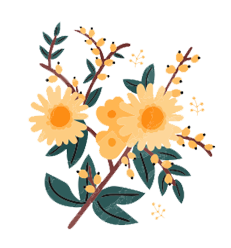Using Herbs to Enhance Your Floral Designs
When it comes to creating memorable floral arrangements, flowers often take center stage. However, there’s a world of greenery that can add layers of fragrance, texture, and symbolism to your designs. Fresh herbs, in particular, offer a unique and versatile way to elevate your bouquets. Whether you’re looking to infuse a bouquet with soothing aromas or add a touch of meaning, incorporating herbs like rosemary, lavender, and mint can transform your floral creations from beautiful to extraordinary. Here’s how you can go beyond the bloom by using herbs in your floral designs.
Why Use Herbs in Floral Designs?
Herbs bring several benefits to floral arrangements:
- Fragrance: Herbs are known for their strong, often soothing scents. Incorporating them into your designs can create an aromatic experience that enhances the overall impact of the bouquet.
- Texture: The varied textures of herbs, from the soft, feathery leaves of dill to the woody stems of rosemary, add depth and interest to floral arrangements.
- Symbolism: Many herbs carry historical and cultural symbolism. For example, rosemary is associated with remembrance, lavender with calm and purity, and mint with virtue and warmth. Including these herbs can add layers of meaning to your designs.
- Longevity: Many herbs are hardy and long-lasting, which can help your arrangements stay fresh longer.
Choosing the Right Herbs
The key to successfully incorporating herbs into your floral designs is selecting the right ones. Here are some popular options:
- Rosemary: With its pine-like scent and sturdy, needle-like leaves, rosemary adds structure and a rich, earthy aroma to arrangements. It’s perfect for more formal designs or those meant to evoke a sense of remembrance.
- Lavender: Known for its calming scent and delicate purple blooms, lavender adds both fragrance and color. It works well in rustic, romantic, or country-style bouquets.
- Mint: The bright green leaves and refreshing scent of mint bring a crisp, lively element to floral arrangements. It pairs beautifully with a wide range of flowers, from soft pastels to vibrant, bold hues.
- Sage: Sage’s soft, velvety leaves and muted green color make it a great filler for adding texture and subtle color to arrangements. It also carries a symbolic meaning of wisdom and protection.
- Thyme: With its small, delicate leaves and woodsy scent, thyme is an excellent choice for adding fine texture and a touch of herbal fragrance to bouquets.
- Basil: Basil’s broad, glossy leaves and sweet aroma make it a standout herb in floral designs. It’s particularly effective in summer bouquets, adding a burst of freshness.
Incorporating Herbs into Your Designs
When integrating herbs into your arrangements, consider the following tips:
- Use as Filler: Herbs like mint, thyme, and sage can be used as fillers to add texture and fragrance without overpowering the main flowers. Their greenery can complement the blooms while contributing to the bouquet’s overall fullness.
- Create a Focal Point: Herbs with more pronounced shapes or colors, such as lavender or rosemary, can be used as focal points. Pair them with flowers that complement their color and shape for a balanced look.
- Herb-Only Bouquets: For a truly unique arrangement, consider creating an herb-only bouquet. These are perfect for rustic weddings or as gifts for cooking enthusiasts. You can also mix herbs with edible flowers for a bouquet that’s as functional as it is beautiful.
- Layering for Effect: Combine herbs with different textures and scents to create a layered, multisensory experience. For example, pair the soft, wispy leaves of dill with the sturdy, aromatic rosemary and the soothing blooms of lavender.
Herbs and Symbolism
One of the most enchanting aspects of using herbs in floral design is the ability to infuse your arrangements with symbolism. Here are some ideas:
- Weddings: Incorporate rosemary into bridal bouquets to symbolize fidelity and remembrance, or use lavender to represent purity and devotion.
- Memorials: Rosemary and thyme are often used in memorial arrangements due to their associations with remembrance and courage.
- Gifts: A bouquet featuring basil and mint can be a thoughtful gift, symbolizing good wishes and warmth.
When using herbs for their symbolic meanings, consider the message you want your bouquet to convey and select herbs that align with that sentiment.
Caring for Herb-Infused Bouquets
Herbs are generally hardy, but they still require proper care to maintain their freshness. Here are some tips:
- Watering: Like flowers, herbs need to be kept in water to stay fresh. Make sure the stems are properly hydrated and trim them regularly to promote water absorption.
- Storage: Store herb-infused bouquets in a cool, shaded area to prolong their freshness. Avoid direct sunlight, which can cause the herbs to wilt.
- Preservation: If you want to preserve an herb bouquet, consider drying it. Herbs like rosemary, lavender, and thyme dry well and can be used for decorative purposes long after the flowers have faded.
Experiment and Have Fun
The beauty of using herbs in floral design lies in the endless possibilities they offer. Don’t be afraid to experiment with different combinations of herbs and flowers, or to create themed arrangements that highlight specific herbs. Whether you’re crafting a rustic bouquet for a countryside wedding or a sophisticated centerpiece for a formal event, herbs can add that extra touch of creativity and meaning that sets your designs apart.
Incorporating herbs into your floral designs is a wonderful way to enhance your arrangements with fragrance, texture, and symbolism. By thoughtfully selecting and arranging herbs, you can create bouquets that are not only visually stunning but also rich in sensory and emotional depth. So, the next time you’re designing a bouquet, think beyond the bloom and explore the world of herbs—you might just discover a whole new dimension to your floral artistry.




